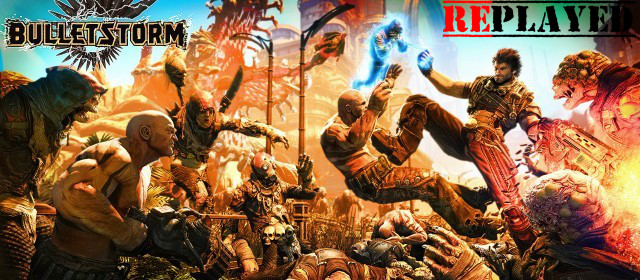The rising sun paints the sky in chemical shades of gold and bronze, streaked here with bloody crimson, there with the grey of noxious smoke; great plants wrap the distant landscape in emerald tendrils peppered with spores of yellow and red. Here and there the scars of industry mar this once-paradise: the rusted husks of derelict factories jut from the earth like broken teeth, while burned-out pleasure resorts blacken the bright horizon. All around are the signs of revolution: bullet holes, scorch marks, gutted buildings – and silence; a deep, unsettling silence.
This is Stygia, once the greatest paradise known to man, a new Eden among the stars to which thousands would flock every year to experience life at the peak of human excess. At the time of Stygia’s hey-day, a labour-force comprised of convicted prisoners maintained the various complexes, and dangerous chemicals siphoned from the atmosphere were stored below the planet’s surface, away from the public eye. It was a powder-keg waiting to be ignited, and when that happened the whole planet went to hell on a rollercoaster; the prisoners revolted, the dangerous chemicals got into the atmosphere and the population mutated, losing their minds and their humanity in the process.
This is the setting of People Can Fly’s brutal and irreverent first person shooter, Bulletstorm, and one of the most dangerous and beautiful game-worlds of recent years.
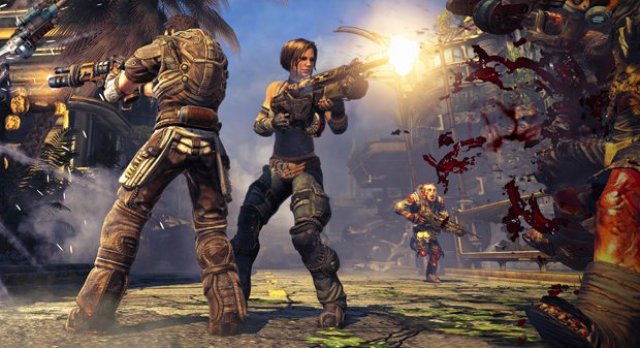
PARADISE LOST: It’s sometimes easy to forget while staring at still images of Stygia’s landscape that Bulletstorm is a loud, crass and wilfully over-the-top FPS. It’s also easy to forget that it was built using Epic Games’ Unreal Engine 3, a platform more often associated with grit and grime and several hundred shades of brown. In actual fact, it was People Can Fly’s interest in using Epic’s proprietary game engine that led to the birth of Bulletstorm in the first place.
The Polish developers (previously famous for creating 2004’s PC-only blaster, Painkiller) had approached Epic about licensing the Unreal Engine 3, and the demo they built was so impressive that Epic hired them to do some of the work on the PC port of Gears of War. It was a move that led to the collaboration of both companies on Bulletstorm, a new shooter that was to be published by Electronic Arts.
While the game put People Can Fly on the map, it’s the influence of Epic that is most keenly felt throughout. The character models and the art style scream Gears of War; the armour worn by the soldiers in Bulletstorm has the same gun-metal grey colouring, blue neon lights that may as well be there purely for decoration and the same ability to show off bulging, grease-smeared biceps. The first-person character movement is familiar too, almost as if you’ve been slammed into Marcus Fenix’s head but had your cosy cover mechanic ripped away. The weight and heft that made controlling Gears’ Marcus and Dom so satisfying is just as prevalent in Bulletstorm; the guns – here far more outlandish and unreal – are just as meaty, the impact of their shots just as solid. Even the scriptwriting – while somehow managing to be even more profane in Bulletstorm – has a similar cadence, its themes of vengeance and redemption shot through with hilarious one-liners and heartfelt bromance.
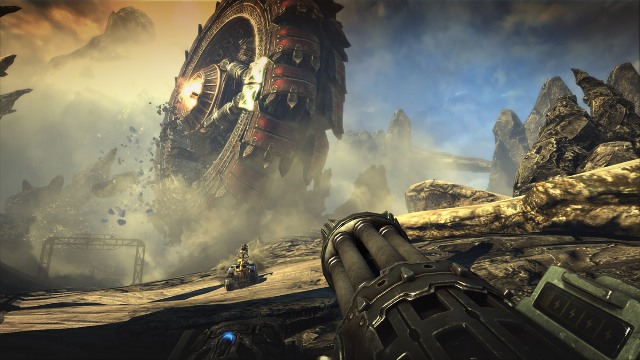
A SUDDEN PLUNGE IN THE SULLEN SWELL: While on the outside Bulletstorm seems crude and unrefined, there is a level of humanity beneath all the snarled oaths and exploded heads that’s easy to miss even while you’re playing. The prologue mission sets the scene perfectly, beginning with a covert assault on a civilian building by Dead Echo, an elite mercenary unit working under the command of Star General Serrano. Led by Grayson Hunt (voiced by the ever-dependable, wonderfully gruff Steve Blum) and his straight-laced partner Ishi Sato, Dead Echo’s job is to wipe the most despicable and immoral scum from all the corners of the galaxy. Or so they believe.
The horrific truth is that Sarrano has been lying to them from day one, using them as his personal hit squad to eliminate anyone who might uncover the more sordid details of his squalid military career. Beginning with a vertical stroll up the side of a building, the prologue mission culminates with an innocent reporter meeting his end at the hands of Dead Echo – and leaving his young daughter fatherless. When Hunt discovers the truth he rebels, goes rogue, gets the hell off Earth, and spends the next ten years drinking, whoring and pirating around the solar system trying to forget the blood on his hands rather than make an honest attempt to wash it off.
Right off the bat there’s a reason to like the bitter, foul-mouthed, Wolverine-haired Hunt – rather than simply shrugging off the innocent lives he’s been tricked into snuffing out, he takes it hard, crashing and burning over and over again in an attempt to escape the horrors of his past and find peace. It’s not that his intentions are bad, it’s simply that he’s not a subtle man, and climbing into a bottle while taking his crew (the other three former members of Dead Echo) on one suicide mission after another is an easier way to deal with what’s gone down than simply asking forgiveness.

TEN FATHOMS DEEP ON THE ROAD TO HELL: So, when a stinking drunk Hunt comes across Serrano’s flagship, the Ulysses, in deep space, he does the only thing that makes sense at the time: He takes it on, regardless of its vastly superior size, strength and firepower. Ultimately, the only course of action is to ram it, head-on, crashing both ships and stranding Dead Echo and several squads of Serrano’s military personnel on the corrupted paradise planet of Stygia.
With two of the crew dead, and the gravely wounded Ishi now a tricked-out cyborg barely retaining his humanity, Hunt sets out to find Serrano and end his life once and for all – hopefully commandeering an escape capsule from the downed Ulysses in the process. However, as with all good action yarns, problems arise with frightening regularity. For instance, it soon becomes apparent that Serrano has been using Stygia as a training ground for Final Echo, the successors to Hunt’s squad. Honing their skills killing the mutated remnants of Stygia’s population has turned Final Echo into a fighting force to be reckoned with – an inconvenient obstacle on Hunt’s road to revenge and redemption.
Then there’s Trishka Novak (Mass Effect’s Jennifer Hale), an elite member of Final Echo and, as luck and fate would have it, the daughter of the man Hunt killed in the prologue. Her shocking potty mouth and abrasive attitude aside, it’s Trishka’s interplay with Hunt that provides most of the tension. She doesn’t know that Hunt killed her father, but once she finds out Serrano was responsible it’s only a matter of time before Hunt’s part in it is revealed – and she’s not the sort to let sleeping dogs lie. There’s a surprising and unappreciated depth to Bulletstorm’s main characters – particularly Hunt, Trishka and Ishi. A moment late in the game when Ishi tells Hunt that he doesn’t hold him accountable for the shit they’ve gone through to get where they are is actually touching, and adds to the impact later on when a reprogrammed Ishi is trying to murder Hunt, whereby Hunt tells him the same thing.
Serrano might be a caricature bad guy, but it’s excusable, maybe even original, in that Bulletstorm’s writers don’t even attempt to make the player empathise with him. Serrano is no sympathetic villain, he harbours no deep-seated emotional scars that force him to commit acts of unspeakable cruelty – he simply is evil, through and through; a despicable, twisted individual who happens to occupy a position of great power and authority. Even the knowledge that he raised Trishka and trained her doesn’t soften his image, as the first time she challenges him, he throws her off a building. He’s there to hate; the “heroes” are muddy enough without confusing the role of the antagonist, and Serrano is exactly the type of villain that a hero like Grayson Hunt needs to maintain balance.
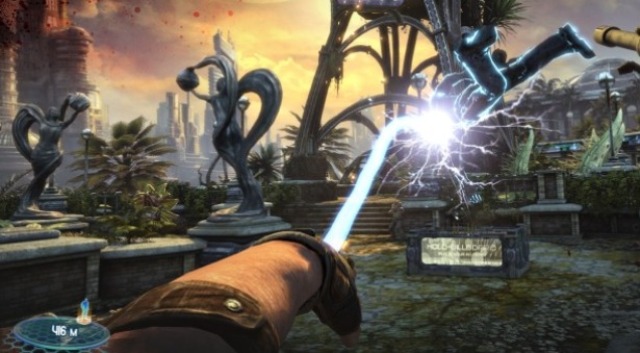
KILL WITH SKILL: But let’s not pretend that Bulletstorm is all about the story. While the plot is compelling and worthy of more praise than many have given it, Bulletstorm’s greatest strength is undoubtedly its gameplay. Like Gears of War on an LSD trip, Bulletstorm’s campaign is an explosive journey from set-piece to set-piece, taking in everything from chases through the desert with a skyscraper-sized cogwheel bearing down on you, to jumping in a rickety gyrocopter to battle a Godzilla-sized dinosaur that your clumsy ass has awoken from its slumber, or facing off against a giant mutated plant that’s smothering the complex with its creeping roots. But even though the big fights are full of character and bombast, the combat is always at its best when you’re engaged in firefights with the enemy infantry. Why? Because of the Instinct Leash, that’s why.
Designed as both an energy-based weapon and a tool for monitoring and recording a soldier’s performance in the stringent tests to which Final Echo recruits are subjected, the Instinct Leash is one of the greatest gadgets in any sci-fi game ever. Able to pull enemies and objects towards you or “thump” the ground to launch them up into the air, the Leash is an indispensable weapon and absolutely vital if you want to find all of Bulletstorm’s incredibly addictive Skillshots.
At a very basic level these are trick kills, found by being experimental and creative with your weapons and the environment. Although Bulletstorm has a relatively small selection of guns, each comes with an alternate, charged fire mode, and it’s often these that will help you unlock Skillshots. For example, the pistol’s secondary mode causes it to fire explosive flares – blind an enemy with one and then kill him and you’ll achieve the Blind Fire Skillshot; kick an enemy onto a spiky environmental feature and unlock Voodoo Doll; kill two goons with one Flailgun explosion and earn a Gang Bang… You get the picture. Each Skillshot earns you points that can be used at “dropkits” to buy ammo and unlock new weapons. Better guns cost more points, so the best killers get access to the best weapons.
Bulletstorm’s combat system is so popular that people are still logging on today attempting to perfect the Echoes, bite-sized portions of the single player missions wherein the objective is to score as many Skillpoints as possible in the fastest time by mixing Skillshots and environment kills. There’s something cathartic about the Echoes with which the shallow, tacked-on co-op mode simply can’t compete. It’s about using the right weapon for the right moment, making quick switches and quick decisions where kills are concerned and acting as much on instinct as forethought. The Echoes are what give Bulletstorm its legs (the campaign clocks in at only a little over 7 hours), and their appeal and replayability are immense.
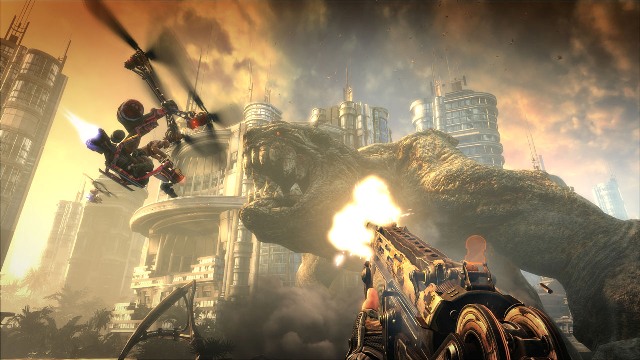
WHAT WE DO IN LIFE: Unsurprisingly, Bulletstorm was the centre of a mild controversy storm concerning the sheer volume of profanity in its script. This is the game that spawned the insult “dick-tits”, and sent up Halo: Reach’s “Believe” diorama with a slow motion video of Hunt murdering mutants and having a long, noisy pee – but it also prompted Fox News to run an article debasing its use of gratuitous bad language and over the top violence in its Skill Kills. Psychologist Carole Lieberman joined Fox News’ panel, claiming:
“Video games have increasingly, and more brazenly, connected sex and violence in images, actions and words. This has the psychological impact of doubling the excitement, stimulation and incitement to copycat acts. The increase in rapes can be attributed, in large part, to the playing out of such scenes in video games.”
Others came forward with similar claims, suggesting that the game was targeted at adolescents or even “children as young as nine”, but all were dismissed without a single hour in court. Bulletstorm’s black humour and mature matter were always going to generate controversy, but such claims were clearly aimed at the video games industry in general with People Can Fly’s game as a likely, and convenient, proxy.
“Bulletstorm is a work of entertainment fiction… The game and its marketing adhere to all guidelines set forth by the ESRB; both designed for people 17+… Much like Tarantino’s Kill Bill or Rodriguez’s Sin City this game is an expression of creative entertainment for adults.” – EA’s response to the Bulletstorm controversy.

ECHOES IN ETERNITY: So why no sequel? Well, although one was in the planning stages for quite a while, People Can Fly appeared to abandon it to instead work on the upcoming Gears of War: Judgment, a prequel to Epic’s bestselling sci-fi franchise. Apparently, poor sales killed the chance of a direct Bulletstorm sequel – yet another example of a great game getting neither the pre-release hype nor the post-release coverage it deserved.
If you’ve never dipped into Bulletstorm’s colourful, frantic and violent world then you’re missing out, but you’re not alone. Many were put off by an overly-shouty trailer featuring muscle-bound dude-bros whooping and cheering while reducing bad guys to bloody fragments, and not nearly enough was made of a story that really is far more than just a reason to swear and kill.
Bulletstorm is not a work of art, despite the undeniable beauty of Stygia’s corrupted environs, but as a game it’s a genuine masterpiece of madness and mayhem, taking something that’s become as mundane as shooting a bad guy and turning it into something similar to a complex competitive sport requiring forethought and planning to perfect. The decaying majesty of a world like Stygia might have been lost on a fan-base who really just wanted to smash through an enemy’s backside with a giant drill gun, but really that’s ok too, because Bulletstorm is a game that revels in its contradictions: beautiful yet corrupt, tonally shallow yet morally deep, vulgar and brash yet surprisingly well written, simple and uncluttered yet complex in its various gameplay systems.
Bulletstorm deserves to be played, if only because there will never be a sequel, and so there will never be another game quite like it.
Bulletstorm was developed by People Can Fly and Epic Games and published by Electronic Arts. It currently holds a Metacritic score of 84/100.


